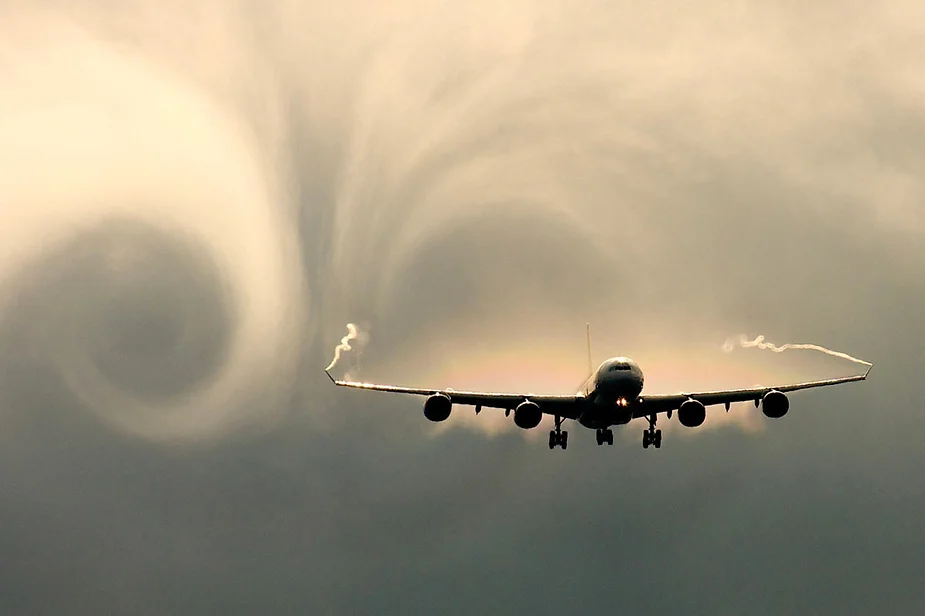Avoiding Wake Turbulence
- gpeppler
- Mar 7, 2024
- 3 min read
Three sharp jolts shook the aircraft. It was like hitting speed bumps, while at high-speed in your car. The aircraft rolled 6 degrees to the right, then 28 degrees past wings-level to the left. The pilot reacted to regain control. Four additional rolls followed, one of a magnitude of 55 degrees, before the aircraft came back, after 18 seconds of drama, to straight-and-level flight.
The cockpit crew, thinking they’d experienced a flight control problem, cut short their flight, and landed at the nearest airport to evaluate what had just occurred. What soon came to light was that this aircraft, an Airbus A319-114 carrying passengers from Victoria to Toronto hadn’t had a control problem at all. In fact, as it was climbing from FL350 to FL370, it flew into the wake turbulence of a Boeing 747-400 travelling in the same direction, at the same altitude to which it had just been assigned. What’s startling is that, at the time of the incident, the aircraft were almost 11 nautical miles apart.
Aircraft that fly directly into the core of a wake turbulence vortex will tend to roll with the vortex. The effectiveness of control response, and the wingspan of the airplane, determines the aircraft’s ability to counteract the roll. If the aircraft’s wingspan and ailerons extend beyond the vortex, countering the roll is usually effective. Aircraft with short wingspans, even those of high-performance, will have greater difficulty counteracting the roll.
Crossing laterally through a vortex can impose dangerously high structural loads on an airplane -- particularly a small one -- flying through the path of such phenomena. The vertical gusts encountered can place a force upwards of 10G on a small airplane, while the combined effect of up gusts and down gusts can be in the order of 80 feet-per-second. Most small airplanes are designed only to withstand vertical gusts of less than half that speed.
Structural failure becomes a distinct possibility for an airplane crossing a pair of vortices at a large angle. Severe up-and-down forces, and a pilot’s attempt to counteract them, can end up exceeding an airframe’s design limits. (It was the first officer’s aggressive rudder use, in response to severe wake turbulence encountered from a previously departed Boeing 747, that ripped the tail off an Airbus A300-600 over New York City in 2001.) Loss of control is another result of vortex encounters. Vortex cores can produce roll rates of 80 degrees-per- second. Small light airplanes, especially, cannot cope with that rate.
Vortices start being produced on take-off, reach their peak at lift-off, and end only once the aircraft has touched down. Vortices of large, heavy airplanes settle below and behind the airplane at up to 500 feet-per-minute for about 30 seconds. The vortices of smaller, lighter airplanes settle more slowly. In all cases, within about 2 minutes, vortices level off about 1,000 feet below the aircraft’s flight path. The vortices may trail the aircraft by up to 16 nautical miles.
Vortex strength remains relatively constant for the first 2 minutes after the generating aircraft has passed. (Thus, a commercial jet flying at over 500 miles-per-hour, is going to cover 16 nautical miles in the passage of 2 minutes of time. That’s plenty of time to encounter the wake turbulence of another aircraft already gone by.) In still air, vortices decay slowly and can last up to 5 minutes. On the other hand, a turbulent atmosphere can help break up vortices such that the greater the turbulence, the more rapid the dissipation of the vortices.
Vortices, in still air, flow outward and downward, although ambient wind will alter their normal pattern of movement. A vortex flow field behind the generating aircraft can cover an area about 2 wingspans in width and one wingspan in depth. Behind a very large aircraft, the rotating vortex may have a diameter as great as 200 feet.
Very large jets, especially, can make the problem of wake turbulence acute. Examples, like the ones stated above, abound of commercial jets suffering greatly at the hands of unseen monster vortices. Imagine, then, what they can do to your Cessna.





Comments